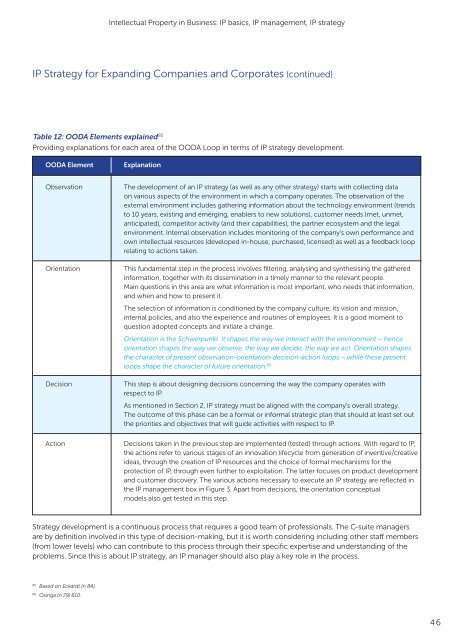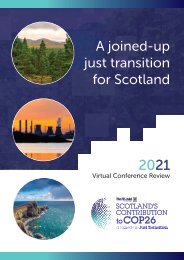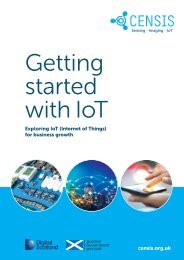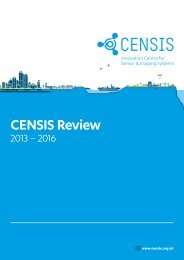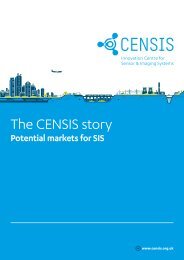CENSIS white paper: Intellectual Property in Business
2023: This CENSIS white paper sets out to make the topic of IP more approachable, less intimidating and more manageable, offering experience-based advice and methods are are designed to help businesses structure their IP- related issues and makes the best of their IP. Covering: The role of IP, IP management during growth, IP strategy for expanding companies and corporates, Business IP Canvas - merging IP with your business model.
2023: This CENSIS white paper sets out to make the topic of IP more approachable, less intimidating and more manageable, offering experience-based advice and methods are are designed to help businesses structure their IP- related issues and makes the best of their IP.
Covering:
The role of IP, IP management during growth, IP strategy for expanding companies and corporates, Business IP Canvas - merging IP with your business model.
You also want an ePaper? Increase the reach of your titles
YUMPU automatically turns print PDFs into web optimized ePapers that Google loves.
<strong>Intellectual</strong> <strong>Property</strong> <strong>in</strong> Bus<strong>in</strong>ess: IP basics, IP management, IP strategy<br />
IP Strategy for Expand<strong>in</strong>g Companies and Corporates (cont<strong>in</strong>ued)<br />
Table 12: OODA Elements expla<strong>in</strong>ed 85<br />
Provid<strong>in</strong>g explanations for each area of the OODA Loop <strong>in</strong> terms of IP strategy development.<br />
OODA Element<br />
Explanation<br />
Observation<br />
Orientation<br />
The development of an IP strategy (as well as any other strategy) starts with collect<strong>in</strong>g data<br />
on various aspects of the environment <strong>in</strong> which a company operates. The observation of the<br />
external environment <strong>in</strong>cludes gather<strong>in</strong>g <strong>in</strong>formation about the technology environment (trends<br />
to 10 years, exist<strong>in</strong>g and emerg<strong>in</strong>g, enablers to new solutions), customer needs (met, unmet,<br />
anticipated), competitor activity (and their capabilities), the partner ecosystem and the legal<br />
environment. Internal observation <strong>in</strong>cludes monitor<strong>in</strong>g of the company’s own performance and<br />
own <strong>in</strong>tellectual resources (developed <strong>in</strong>-house, purchased, licensed) as well as a feedback loop<br />
relat<strong>in</strong>g to actions taken.<br />
This fundamental step <strong>in</strong> the process <strong>in</strong>volves filter<strong>in</strong>g, analys<strong>in</strong>g and synthesis<strong>in</strong>g the gathered<br />
<strong>in</strong>formation, together with its dissem<strong>in</strong>ation <strong>in</strong> a timely manner to the relevant people.<br />
Ma<strong>in</strong> questions <strong>in</strong> this area are what <strong>in</strong>formation is most important, who needs that <strong>in</strong>formation,<br />
and when and how to present it.<br />
The selection of <strong>in</strong>formation is conditioned by the company culture, its vision and mission,<br />
<strong>in</strong>ternal policies, and also the experience and rout<strong>in</strong>es of employees. It is a good moment to<br />
question adopted concepts and <strong>in</strong>itiate a change.<br />
Orientation is the Schwerpunkt. It shapes the way we <strong>in</strong>teract with the environment – hence<br />
orientation shapes the way we observe, the way we decide, the way we act. Orientation shapes<br />
the character of present observation-orientation-decision-action loops – while these present<br />
loops shape the character of future orientation. 86<br />
Decision<br />
This step is about design<strong>in</strong>g decisions concern<strong>in</strong>g the way the company operates with<br />
respect to IP.<br />
As mentioned <strong>in</strong> Section 2, IP strategy must be aligned with the company’s overall strategy.<br />
The outcome of this phase can be a formal or <strong>in</strong>formal strategic plan that should at least set out<br />
the priorities and objectives that will guide activities with respect to IP.<br />
Action<br />
Decisions taken <strong>in</strong> the previous step are implemented (tested) through actions. With regard to IP,<br />
the actions refer to various stages of an <strong>in</strong>novation lifecycle from generation of <strong>in</strong>ventive/creative<br />
ideas, through the creation of IP resources and the choice of formal mechanisms for the<br />
protection of IP, through even further to exploitation. The latter focuses on product development<br />
and customer discovery. The various actions necessary to execute an IP strategy are reflected <strong>in</strong><br />
the IP management box <strong>in</strong> Figure 3. Apart from decisions, the orientation conceptual<br />
models also get tested <strong>in</strong> this step.<br />
Strategy development is a cont<strong>in</strong>uous process that requires a good team of professionals. The C-suite managers<br />
are by def<strong>in</strong>ition <strong>in</strong>volved <strong>in</strong> this type of decision-mak<strong>in</strong>g, but it is worth consider<strong>in</strong>g <strong>in</strong>clud<strong>in</strong>g other staff members<br />
(from lower levels) who can contribute to this process through their specific expertise and understand<strong>in</strong>g of the<br />
problems. S<strong>in</strong>ce this is about IP strategy, an IP manager should also play a key role <strong>in</strong> the process.<br />
85<br />
Based on Eckardt (n 84).<br />
86<br />
Os<strong>in</strong>ga (n 79) 610.<br />
46


